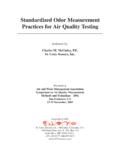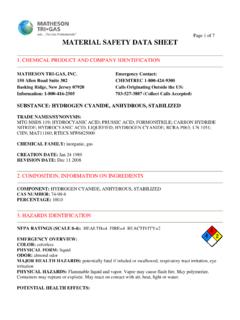Transcription of SEWER SIPHONS AND ODOR CONTROL: A PRACTICAL …
1 SEWER SIPHONS AND ODOR control : A PRACTICAL approach . *David Bennett, , Lizanne Douglas, , Rebecca Musk, EIT. Freese and Nichols, Inc. 1017 Main Campus Drive, Suite 3100, Raleigh, NC 27606-4929. *PH: (210) 298-3800. *Email: ABSTRACT. SIPHONS , sometimes called depressed sewers or sags, allow wastewater to flow through a pipe under low lying areas or obstructions such as rivers, utilities, or other obstructions, where flow by gravity at these locations is impossible. The flow through a siphon is driven by a difference in hydrostatic pressure without the need for pumping. A major drawback with SIPHONS is foul odor created from the displaced air flow at upstream siphon structures. The evacuation of air occurs during the transition from gravity flow in the upstream wastewater main to pressure flow in the siphon .
2 SIPHONS are commonly used in combination with an air jumper or an odor control design methodology, such as carbon filters or scrubbers. Air jumpers are air pipes used to prevent SEWER headspace pressurization within the pipeline and capture odorous SEWER gasses which help to maintain the SEWER ventilation within the pressurized siphon . Air jumpers span the length of the siphon from box to box. Another method of odor control is the use of liquid phase or vapor phase treatment, which work to treat and control the escape of these gases and odors to the atmosphere. Although there have been a few research papers, guidelines, and rules of thumb published, there is not an abundance of industry information available on the design of SIPHONS in combination with air jumpers. However, for air jumpers, there are PRACTICAL concepts of fluid mechanics that need to be followed in order for the process to work.
3 In other cases, liquid or vapor phase systems are used for odor control , or no odor control system is implemented at all. This paper discusses the various guidelines or rules of thumb and empirical data/criteria for air jumper design including fluid/air flow characteristics, minimum pipe size, velocities, and other assumptions, as well as the pros and cons of using air jumpers versus other odor control methods. Another focus of this paper is to provide analysis through case studies including the design and construction of SIPHONS with air jumpers and odor control systems as well as the addition of air jumpers to existing SIPHONS in the form of a retrofit replacement. Advantages and disadvantages of constructability, operations, and maintenance of the air jumper and odor control system designs will also be presented.
4 KEYWORDS. SEWER , siphon , Odor control , Air Jumper SEWER SIPHONS and Odor control : A PRACTICAL approach INTRODUCTION. There are various design methods and owner preferences for siphon design and odor/air control . The purpose of this paper is to provide general guidelines for siphon design, a discussion of air flow considerations with regards to odor control in sewers, and comparisons of odor control methods including liquid-phase and vapor-phase treatment. This paper also includes case studies that have implemented various odor control methods. Several published sources provide design guidelines on siphon design and hydraulics; however, there are more limited resources of published guidance on mitigation of odors at SIPHONS . There is a shortage of information, especially regarding estimation of upstream air flow and volume which is a key component to sizing odor control systems.
5 For this paper, several published sources were reviewed including published books, reports, studies, and conference papers. Through this research, several Rules of Thumb regarding air flow in collection systems emerged. As suggested in several published sources, there is still a research gap on the subject and more industry research is needed. METHODOLOGY. SIPHONS SIPHONS are used to allow a liquid, in this case wastewater, to flow through a pipe under low lying areas or obstructions such as rivers, streams, dips in elevations, railroads or other utilities, where flow by gravity is impossible. SIPHONS achieve flow due to the difference in hydrostatic pressure, eliminating the need for pumping. The flow changes from upstream gravity flow to pressurized flow through the siphon sections. Generally, SIPHONS are not preferred unless absolutely necessary for grade issues because of the maintenance requirements.
6 As such, access points and provisions need to be included in design to allow for periodic maintenance. Regulatory agencies typically require two or more siphon barrels, usually sized to handle low and high flows. This allows for one barrel to be temporarily shut down for servicing and cleaning. Normal flow is diverted to one barrel with a typical minimum pipe diameter of 6-inches. Lastly, a minimum flushing velocity of 3 fps at initial and design flows is recommended. Flows into the siphon barrels are commonly controlled with upstream weirs. Understanding Air Flow One challenge with SIPHONS involves the air that is displaced as the liquid enters the pressurized section of the pipeline. The only way for air to escape is to exit the inlet siphon structure through vents or at upstream manholes.
7 To prevent vapor lock, vents are required at the downstream end of SIPHONS which allow air to be pulled back in to the gravity system. If upstream vents are located in highly populated areas, odors can be a concern. Odors are particularly problematic during lower flows when the formation of hydrogen sulfide is more prevalent. The first step of odor control is determining the upstream air flow characteristics. This starts with an analysis of many complex physical variables including friction drag, wastewater level within a pipe, temperature, and barometric pressure. High wastewater flows tend to produce a greater frictional drag which leads to greater air movement. Airflow velocity is highly dependent on depth and velocity of the liquid (Pescod, 1981), which is greatly variable for most WW collection systems that have diurnal patterns that correspond to wastewater usage.
8 Air flow calculations are made more complex by vertical drops, junction and diversion structures, SIPHONS , and pump stations. However, there are many different methods and opinions in the SEWER SIPHONS and Odor control : A PRACTICAL approach wastewater industry on how air flow velocities should be determined. There are several Rules of Thumb suggested in available industry design guidance (WEF, 1983; Clow, 2004) that suggests three common ideas: (1) airflow velocity will be 35% - 50% of liquid velocity in a 1/2 full pipe, (2). maximum airflow is at 1/2 full pipe because surface exposure is maximized above the headspace, and (3) very slow velocity moves small volumes of air. Recent reports and industry guidance suggest that much more research is needed to develop better understanding of air flow within collection systems.
9 Odor control Odors in collection systems are typically handled in one of two ways: liquid-phase or vapor phase treatment (Landers, 2007). Liquid-phase treatment such as chemical injection, nitrate salts, and iron salts helps to inhibit odors by preventing the formation or removing Hydrogen Sulfide (H2S). from the pipeline. H2S is formed by the bacterial breakdown of organic material in the sewage. The H2S gas reacts with moisture in the pipe to form sulfuric acid which leads to corrosion of the top of the pipe. The formation of H2S can be prevented with nitrate salts. Alternatively, iron salts remove H2S that is already present in the wastewater. Another liquid phase treatment method is to inject oxidizers (hydrogen peroxide, sodium hypochlorite or potassium permanganate) but this method requires more space for equipment and is better suited for a treatment plant or lift station site.
10 Odor control using vapor phase treatment, prevents odors from exiting the collection system. This method is common for upstream siphon head structures where pressurization and odor release occurs. There are several alternative treatments including activated carbon and wet chemical scrubbing. Activated carbon is widely used for treating odors in simple collection systems, and it is often used at lift stations, SIPHONS , and manholes. Carbon canisters require less maintenance than some alternatives, but an electric power source is needed to operate the vent fan. Wet chemical scrubbing using sodium hypochlorite and sodium hydroxide is a viable alternative method, but there are strict safety requirements for transportation, handling and storage. Due to the safety requirements, this method may be better suited for secured wastewater treatment plant (WWTP) site or lift station site.






